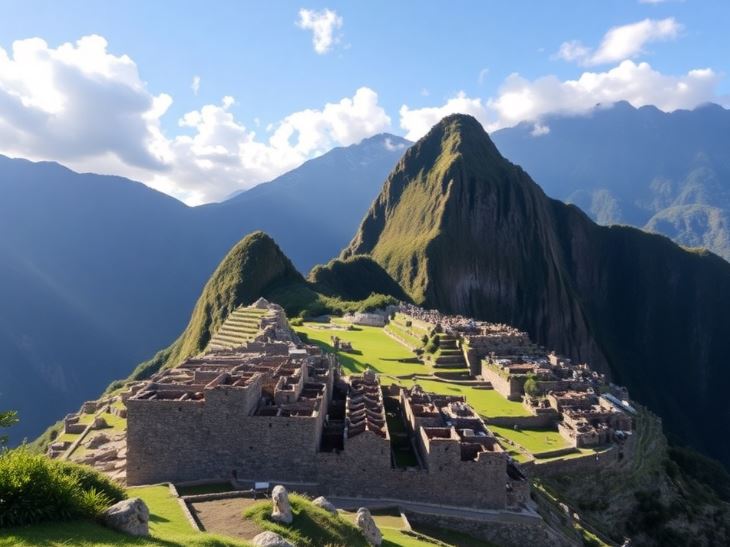
Perched high in the Andes Mountains of Peru, Machu Picchu stands as a testament to human ingenuity and endurance—an Incan citadel cloaked in mist, cradled by jagged peaks, and steeped in mystery. For adventurers and history buffs alike, this UNESCO World Heritage Site is more than a destination; it’s a pilgrimage, a bucket-list crown jewel that promises both a physical challenge and a brush with the past. Year after year, Machu Picchu draws visitors from across the globe, lured by its breathtaking beauty and the allure of uncovering a civilization lost to time. This article explores why this ancient marvel continues to captivate, delving into its history, the trek to reach it, and its enduring pull as a travel icon. From rugged trails to sacred stones, here’s why Machu Picchu remains an unmissable odyssey.
The Incan Legacy: A Window into a Lost World
Machu Picchu isn’t just a pretty postcard—it’s a portal to the Incan Empire, a civilization that thrived in South America from the 13th to 16th centuries. Built around 1450 and abandoned a century later, this mountaintop retreat has puzzled archaeologists and enchanted travellers since its rediscovery.
A Citadel in the Clouds
Tucked at 2,430 metres above sea level, Machu Picchu was likely a royal estate or religious sanctuary for Incan elites, though its exact purpose remains debated. Constructed without mortar, its granite walls—fitted with precision that defies modern tools—have withstood earthquakes and centuries of neglect. The site spans 325 square metres, with terraces, temples, and homes carved into the mountainside. The UNESCO designation praises its “outstanding universal value,” noting its harmony with the rugged landscape.
Rediscovered in 1911 by American explorer Hiram Bingham, Machu Picchu was overgrown with jungle, its secrets hidden from Spanish conquistadors who never found it. Bingham’s accounts, published in *National Geographic*, sparked global fascination, cementing its status as an archaeological marvel.
Why It Endures
The citadel’s mystique lies in its unanswered questions—why was it built so high, and why abandoned? Theories range from a retreat for Emperor Pachacuti to a cosmic observatory aligned with the stars. Its preservation, thanks to isolation, offers a rare glimpse into Incan life: agricultural terraces fed thousands, while temples like the Sun Gate hint at spiritual depth. For history lovers, it’s a living textbook; for adventurers, a challenge wrapped in enigma.
- Construction: Mortar-free stonework, earthquake-resistant for centuries.
- Purpose: A royal haven or sacred site—still a mystery.
- Rediscovery: Hiram Bingham’s find put it on the world stage.
The Journey: Adventure Meets Awe
Getting to Machu Picchu isn’t a stroll—it’s a quest. Whether hiking rugged trails or riding a scenic train, the journey amplifies the reward, blending physical exertion with jaw-dropping vistas.
The Inca Trail: A Trekker’s Rite of Passage
The classic route, the Inca Trail, is a 42-kilometre, four-day hike from Cusco through the Sacred Valley to Machu Picchu’s Sun Gate. Climbers ascend to 4,200 metres at Dead Woman’s Pass, navigating ancient stone paths, cloud forests, and Incan ruins like Wiñay Wayna. The Peru Travel site calls it “one of the world’s greatest treks,” with only 500 daily permits (200 for hikers, 300 for porters) to protect the route.
The payoff? Sunrise over Machu Picchu, with mist peeling back to reveal the citadel below. Trekking companies report that 80% of hikers rate this moment as life-changing—a statistic borne out by countless Instagram posts captioned with awe.
Alternative Paths and Trains
Not up for a multi-day hike? Alternatives abound. The Salkantay Trek, a tougher 74-kilometre option, swaps jungle for glacial peaks. For a gentler approach, trains from Cusco or Ollantaytambo whisk visitors to Aguas Calientes, the gateway town, in under four hours. PeruRail’s panoramic cars offer luxury, while budget-friendly Expedition trains keep it accessible. From there, a 20-minute bus climbs to the site—adventure optional, history guaranteed.
- Inca Trail: Four days, 42 km, and a sunrise finale.
- Salkantay: A longer, wilder trek for the bold.
- Train Option: Scenic rides make it reachable for all.
Case Studies: Travellers Tell the Tale
Machu Picchu’s draw isn’t abstract—it’s personal. Real stories from visitors highlight why it’s a bucket-list staple.
The Solo Adventurer: Conquering the Trail
Meet Jake, a 28-year-old from Seattle who tackled the Inca Trail solo with a guided group. “The altitude hit hard—3,000 metres felt like climbing with weights,” he recalls. “But reaching Inti Punku at dawn, seeing Machu Picchu unfold—it was worth every gasp.” Jake spent a day exploring the site, marvelling at the Temple of the Condor and the precision of the Intihuatana stone. “It’s not just the view—it’s knowing people built this 600 years ago, up here.”
The Family Quest: History for All Ages
Then there’s the Lopez family from Texas, who opted for the train. With kids aged 10 and 14, they wanted history without the hike. “The train was a blast—mountains out every window,” says Maria, the mom. At Machu Picchu, a guide brought the ruins to life, pointing out agricultural terraces and the Sun Temple. “My youngest kept asking how they carried the stones up,” she laughs. “It sparked something in them.” For the Lopezes, it was a bonding trip with a side of education.
The Numbers: Machu Picchu’s Global Pull
Machu Picchu isn’t a niche attraction—it’s a tourism titan, drawing crowds that underscore its bucket-list status while testing Peru’s preservation efforts.
Visitor Surge
Before its modern fame, Machu Picchu saw a trickle of explorers. Today, it welcomes over 1 million visitors annually, with peaks nearing 1.5 million, per UNWTO data. Peru’s tourism sector, boosted by this influx, accounts for 10% of GDP, says the World Bank. Most come from the U.S., Europe, and Latin America, with Americans leading the pack—drawn by proximity and the citadel’s mythic aura.
Managing the Crowds
Success brings strain. Overtourism threatens the site, prompting Peru to cap daily entries at 2,500 (up from 5,000 in busier years) and enforce timed slots. The Inca Trail’s 500-permit limit further controls impact. Conservationists warn of erosion and litter, yet measures like mandatory guides and waste bans show progress in balancing access with preservation.
- Annual Draw: 1–1.5 million visitors, a global magnet.
- Economic Lift: Fuels 10% of Peru’s economy.
- Crowd Control: Caps and rules protect the site.
Why It’s Bucket-List Gold
Machu Picchu’s allure isn’t fleeting—it’s rooted in its blend of adventure, history, and sheer spectacle. It’s a rare place where nature and human achievement collide.
Adventure Meets Meaning
For thrill-seekers, the trek—whether Inca or Salkantay—is a badge of honour, testing stamina against stunning backdrops. For history enthusiasts, it’s a tangible link to a pre-Columbian world, unspoiled by conquest. The National Geographic calls it “a wonder worth the effort,” a sentiment echoed by countless visitors who rank it atop their lists.
A Universal Quest
Its appeal spans generations and borders—solo backpackers, families, retirees—all find something here. The physical journey mirrors an inner one, a chance to reflect amid ancient stones. Add Instagram-worthy views, and Machu Picchu’s status as a social media darling keeps it trending.
The Future: Sustaining a Wonder
Machu Picchu’s pull shows no sign of waning, but its future hinges on stewardship. Sustainable tourism—better trails, eco-friendly transport, and community benefits—could ensure it thrives for centuries more. For now, it stands as a beacon, calling those who crave both the wild and the wise.
Conclusion: Machu Picchu’s Timeless Triumph
Machu Picchu endures as a bucket-list titan because it delivers on every front—adventure that tests the body, history that stirs the mind, and beauty that lifts the soul. From the Inca Trail’s rugged ascent to the citadel’s stone-hewn secrets, it offers a journey unlike any other, drawing over a million dreamers annually to Peru’s Andes. It’s a place where the past feels alive, where nature and culture entwine, and where every visitor, from trekkers to train-riders, leaves with a story. As preservation efforts evolve, Machu Picchu’s legacy holds firm—a testament to Incan brilliance and a call to explore one of the world’s greatest wonders.



